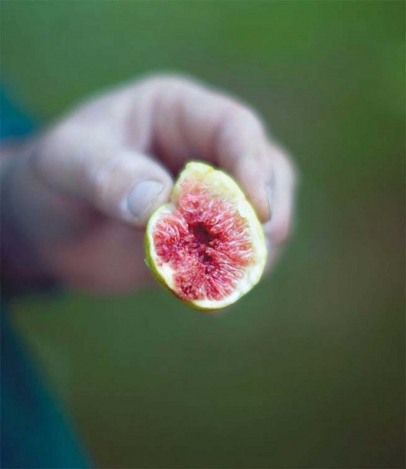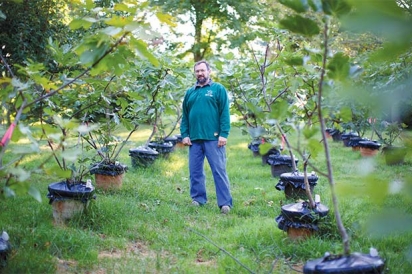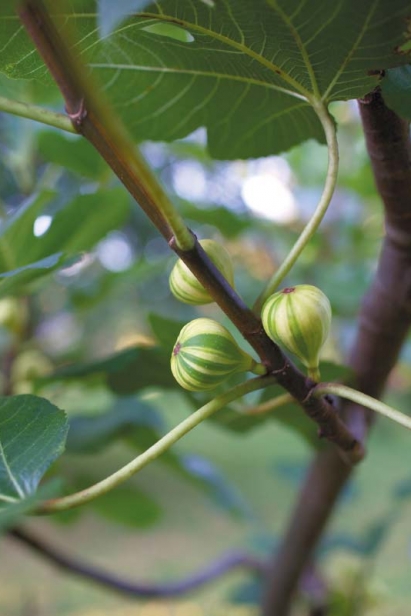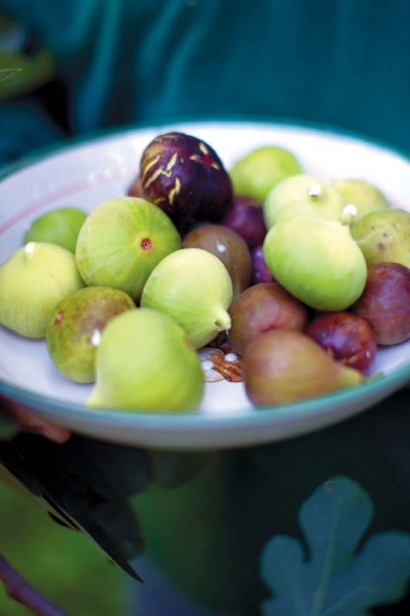For the Flemington Figs
In Flemington, Bill Muzychko wants to sell you a fig tree that’s easier to keep alive
Every November, Bill Muzychko’s fig trees disappear from the grove behind his Flemington home. All 800 of them. Then, come April, once the threat of a deep frost has passed, he wheels them out of his garage and back to the grove in the special pots he designed.
Muzychko, a retired environmental engineer, has been likened to a trimmer and handsomer Norm Abram by his customers. He is precise and straightforward when talking about his trees or system. He calls his fig tree business Bill’s Figs. The system is Bill’s E-Z Care Fig Tree.
Muzychko designed the system to provide for easy watering and mobility. It starts with 12 fourinch PVC rings placed in the bottom of a 25-gallon plastic pot. These are filled with water through a pipe. A wire mesh goes over the rings and, on top of that, a burlap sheet. About 14 inches of mushroom soil is then added. The fig tree is planted on top of the soil, with more soil added around it. Lastly, a snug-fitting piece of plastic is placed around the tree and secured with a bungee cord.
Devising the E-Z Care system was easy, Muzychko says. Coming up with the right mixture of mushroom soil, lime and fertilizer to keep the pH level perfect for the fig trees was not. After killing a few trees, he hit on the right mix, which has a pH of about 7.6.
Muzychko has also devised a fig carrier, a cross between a dolly and a wheelbarrow that slips under the pot for easy transportation during seasonal migrations.
If you’re lucky and come in the fall when Bill’s figs are ripe, he will usually let you taste them. But the real reason customers come to Bill’s Figs is to buy his trees. He will gladly explain the attributes of each of his 230 varieties.
The common fig tree originated on the Anatolian peninsula of Turkey. By prehistoric times the fig had spread to the Mediterranean, where it later became one of the most important fruits of Italy and Greece, along with olives and grapes. Though these semitropical trees can’t tolerate winters in the American Northeast, early Italian and Greek immigrants weren’t about to give up their figs just because they were moving to a colder climate. To protect their treasured trees they devised methods still practiced today.
The earliest method consists of wrapping the fig tree in burlap, which is fastened in place with heavy-duty clips or safety pins; a more modern variation employs heavy plastic and duct tape. It’s a job that usually requires at least two people as well as steadiness on a stepladder. The second method isn’t any easier. It entails a hard day’s work of burying the tree branches by carefully and slowly bending the trunk till the branches reach the ground and then covering them in dirt.
Again, hardly a one-person job.
So Muzychko developed his own method—an easy way to wheel the fig trees indoors for the winter. This past winter, while polar temperatures destroyed many “protected” outdoor fig trees, Muzychko’s enjoyed their dormant season undisturbed in his garage, where temperatures never dipped below 32°.
Muzychko confesses to never having tasted a fresh fig until he was 45 years old. What he did know was that he loved Fig Newtons. Never could get enough, he says. About 13 years ago, he began thinking it was time he bought a fig tree. Around the same time, a nearby farmer had two he wanted to sell. Perhaps it was serendipity.
From the taste of his first fresh fig, Muzychko was hooked. Those first two trees—a Sicilian and a Brown Turkey—stand over eight feet tall now, with each bearing an average of 250 figs or more every year. Trees start bearing fruit by the second year. Usually about ten figs per tree, Muzychko says, increasing in number to 120 by the fifth year. After that, 240 or more can be expected. Common fig trees, like the Mission, Kadota and Brown Turkey, bear what’s called a breba crop, a spring crop from last year’s growth. As with the other varieties, their main crop comes in the fall with new growth.
The figs on Muzychko’s many varieties of fig trees vary in size and shape, but most striking is their spectrum of colors and flavors. The peels range from white to green to brown to purple to black with many shades in between, some even sporting green stripes. Underneath the peels, the flesh of the figs can be brilliant red, daffodil yellow or burnished gold.
Then there’s their incredible taste. Some impart notes of strawberry, honey or peach; others, pink grapefruit, grass or lemon. It’s not surprising that figs are often compared to wines: the earthy Black Mission to a Cabernet, the Kadota to a Sauvignon Blanc and the Brown Turkey to a Pinot Noir. Figs aren’t just delicious fruit prized by chefs. (Actually, figs aren’t fruit but the tree’s flowers.) They’re loaded with more antioxidants than red wine, pack more fiber than most fruits and deliver potassium to help lower blood pressure. Plus, at only 37 calories, they are a savvy dieter’s choice for satisfying a sweet tooth.
Before cooking with them, try them freshly picked. They need no adornment. Eat within three days of picking, Muzychko advises, or freeze them for later. Just never pick figs before their time, he cautions. Only when they’re plump, soft, and juicy, never hard. Late August to mid-September is prime plucking time.
On a visit last September, when the figs had reached their apex in ripeness, I, along with two new customers, Steve Zuli from Marlton and Anthony Paola from Berlin, taste our way through Muzychko’s fig grove. After savoring a Sicilian, Paola says, “Oh, this is really good.” We nod in agreement. Next, a very juicy Osborne elicits exclamations of delight—and requests for napkins for our juice-stained faces.
Though it’s difficult to decide which is my favorite, the yellow- greenish Saint Anthony surprises me the most. As I bite into it, it bursts with a wonderful citrusy mix of lemons and limes.
Turning to Muzychko, I ask if he has a favorite.
“Whichever I’m eating at the moment,” he says.
Bill’s Figs
329 Old York Rd., Flemington
908.806.4887








